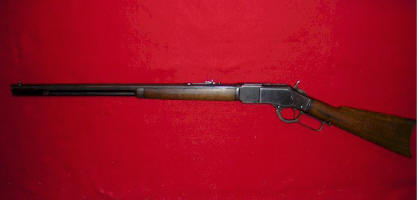 |
|

Introduction | I. History of Winchester Rifles | II. Models | III. Styles | IV. Outline of Features | V. Condition | VI. Diagrams
You have determined the model of your Winchester. Now you will need to determine what type STYLE of 1876 you have. All three style rifles were produced in the First, Second and Third model series.
Step 2: Determine the Style
Select one of the following choices
| The barrel is 28" long, is either full octagon, round or 1/2 octagon, stock is straight with crescent metal butt plate and forearm is capped -- You have the Sporting Rifle style 1876. | |||
| The barrel is 26" long, is either full octagon, round or 1/2 octagon, stock is straight with crescent metal butt plate and forearm is capped -- You have the Express Rifle style 1876. | |||
| The barrel is 22" long and round, stock is straight with rounded iron metal butt plate and saddle ring, and a single barrel band is over the forearm that has barrel-length wood-- You have the Carbine style 1876. | |||
| The barrel is 32" long and round, rounded butt plate and forearm runs the length of the barrel and has one barrel band--You have the Musket style 1876. | |||
If there are other extra features not
mentioned, and they look original. -- You may have
a factory "extra- option". You may need to consult a professional
appraiser to determine the added value of your gun beyond the 'standard' value
provided herein.
|
|
Be sure that the Model of your gun is recorded in the column to the right |
|
Once you have determined the model and style, you might want to study the Outline of Features for possible modifications to the original rifle.
NOW proceed to STEP #3 to determine the condition of Your Gun
Introduction | I. History of Winchester Rifles | II. Models | III. Styles | IV. Outline of Features | V. Condition | VI. Diagrams